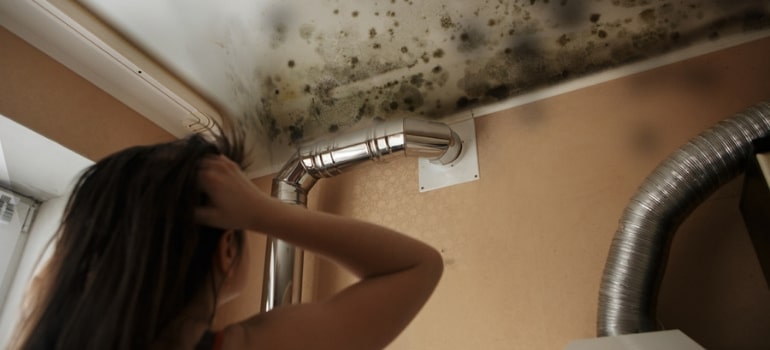Last update: 8 months ago

Mould is an annoying household problem that may seem harmless and manageable but could turn out to be complicated and even health-threatening. Walls and ceilings appear to be favourite growing spots for the living substance, which could only expand and destroy a material’s structure until the proper measures are taken. Knowing what they are and how to apply them properly will save you money and prevent further complications.
While mould is essential for the biodegradation of organisms in nature, it could be dangerous for people in confined spaces. The threat comes from the spores that the fungus releases, which are invisible and easy to inhale. Constant exposure to mould could lead to frequent headaches, allergies, respiratory problems and help the development of respiratory problems.
Causes of mould growth on ceilings
Mould appears on ceilings due to dampness caused by roof damage and leak, high humidity levels, bad ventilation, cooking, condensation, etc. Once it appears, mould will spread fast, actually way faster than it would outdoors. Therefore, the moment you notice stains in black or greenish, you have to react quickly to prevent further contamination of the ceiling.
Identifying mould on ceilings
The term mould refers to different types of fungus, which prefer food and places with high humidity as favourite growing spots. The most likely areas where mould can be seen are the walls and ceilings of bathrooms, kitchens, garages, and window frames, especially in parts of the house that are poorly ventilated.
The different types of mould can have a different impact on our health. Moulds with brown or green colour could cause mild reactions like skin irritation, sneezing and the likes. Pink mould, which is often found in damp bathroom areas, can also cause respiratory issues if not dealt with. Black mould, on the other hand, is quite toxic for humans. It is not hard to distinguish it, and its extermination would most likely require professional assistance.
Steps for removing mould from a ceiling
Cleaning ceiling mould is a tough job and will require persistence. In most cases, a single cleaning is not sufficient. In addition to the right products, you will also need the right equipment.
Step 1. Safety precautions
Staying safe during the cleaning depends on keeping the equipment on at all times. Check it carefully prior to beginning, especially the gloves, for any holes and rips. Remember that chemicals can penetrate our bodies through the skin, so wash well with water and soap in case of an accident.
Reaching the ceiling is not easy either, which means that you have to be extra careful when climbing up. Use a ladder instead of a chair and make sure it’s positioned on a level surface. Consider all risks carefully before deciding to deal with the mould problem on your own. Sometimes it is better to leave certain jobs to the experts.
Step 2. Cleaning supplies
To clean the mould you’ll need:
- Rubber gloves
- Mask
- Sponge
- Safety glasses
- Spraying bottle
- Bucket of water
Step 3. Steps involved
Once you have the equipment on, it is time for action. You could try various methods for killing mould, but we’ve selected the most effective ones.
Isolate the affected area. Take precaution and move plants and valuables away of the area you’re about to treat. Children and pets shouldn’t be in the room either.
- Prepare solution. The market offers all kinds of cleaning products, specialising in mould eradication. The majority of mould-removing chemicals rely on one strong ingredient for effective results – bleach. Alternative cleaning methods are also available. This is where white vinegar, baking soda, essential oils and similar products come in handy. Separately, each one of them has the potential to eliminate fungal colonies, but together they are even more effective. Just mix two parts white vinegar with one part water. Then add one or two tbs of baking soda and several drops of tea tree oil. Some foam could form when the vinegar reacts with the baking soda, so use a bigger container just in case. You can replace the tea tree oil with clove oil, which also works well against mould.
- Apply solution. Pour chlorine bleach directly into the bottle and start spraying all mouldy areas on the ceiling. Remember to pay most attention to the corners, which are usually harder to clean. Once sprayed, let the solution do its magic. You can still rinse with water if the smell is too much for you.
- Air out the place. Open all windows to let the toxic fumes out and let the bleach work for about 30 minutes. The product should erase all mould build-ups, but, if necessary, scrub with the sponge as well.
- Scrubbing process. Scrub and then rinse the area with water and let the ceiling to dry. Keep in mind that bleach is a strong chemical product, which makes it dangerous for people with allergies, sensitive skin, as well as kids.
Step 4. Drying out the area
Let the place dry out completely, either by opening windows, using dehumidifiers or using fans. Natural products and will evaporate faster than the chemical ones after some good airing.
Prevention tips
Now that you know what’s causing the problem, you can avoid having a mouldy ceiling by taking the necessary precautions.
Prevent mould formation on ceilings and walls by doing the following:
- Perform regular house checks, especially if you live in a rental property as mould could be an issue during a routine inspection;
- Inspect plumbing and gutters and do repairs on time;
- Install insulation on external walls that are shady or constantly exposed to water;
- Schedule frequent and thorough cleaning sessions or consider hiring a professional cleaner to help;
- Improve ventilation;
- Avoid drying laundry, towels and the likes inside the house;
- Throw out mouldy food and other affected things as soon as possible.
You should eliminate the source. Your efforts to eliminate ceiling mould will be pointless unless you take care of the source first. Mould doesn’t appear without reason, so you need to inspect the roof for any holes and possible damage.
If the mould is affecting the wall, too, that could be a result of a pipe leak. Sometimes mould could remain hidden within the walls of your home and grow there unnoticed. If you are suspecting that’s the cause for the dark stains, call a specialist right away.
Conclusion
Mould is stubborn, which means that you may have to repeat the whole procedure several times. Unless the reason that’s causing the problem is eradicated, the mould will continue to come back after months, sometimes even days.
That’s why you need to pay special attention to the cleaned area. Daily checks will help you catch the fungi growing back on time. There is also the option of scraping the old paint off and repainting. This time look for anti-mould or mould-resistant paint, which will help you keep the ceiling dry and clean. If all else fails – you can always book a one-off cleaning service to take the matter off your shoulders.
Do you need a helping hand?
Hire a professional cleaning team!








